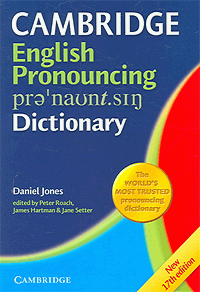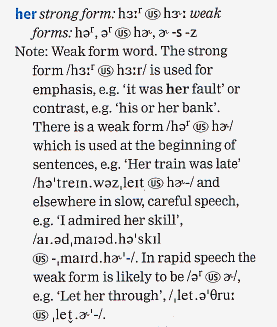Review of the Cambridge English Pronouncing Dictionary (17th edition)

The English Pronouncing Dictionary (EPD) is one of the most well-known works on English pronunciation. Its first edition, published in 1917 and written by Daniel Jones, used symbols of the International Phonetic Alphabet to represent the pronunciations of English words. This system of transcription was further improved by A. C. Gimson in the 13th edition of the EPD (published 1967). Gimson’s system is now used by nearly all English dictionaries published in the UK, including those from Oxford, Longman and Collins.
The first 14 editions of the EPD covered only British English. The 15th edition (1997), published by Cambridge University Press and edited by Peter Roach, James Hartman and Jane Setter, introduced American pronunciations. The changes in the 16th edition (2003) were relatively small — new words and over 150 “information panels” explaining phonetics terminology. The 17th edition (2006) has continued the slow evolution, with the addition of further words and a “Study pages” section with a very brief introduction to English pronunciation, rhythm and intonation.
Why is a pronunciation dictionary useful?
Here are the advantages of a specialized pronunciation dictionary, such as the EPD, over a general dictionary with definitions of words:
- More words. A pronunciation dictionary can list pronunciations for more words than a general dictionary. It can include first names, last names, geographical names, company names, trademarks, etc.
-
Word forms. It can give the pronunciations for inflected forms of words — e.g.
starts, started, starting — not only for the main form like start.
This is especially helpful for beginner learners, who can learn that e.g. goes
ends in
z, nots. -
More pronunciation variants. A pronunciation dictionary can list
more ways to pronounce the same word. Specifically, it can explain how
to pronounce a word in a sentence. For instance,
and is pronounced
/ænd/, but “and all” may be pronounced/ən ˈɔ:l/. - More precise transcriptions. It can use additional symbols to give more detailed information on pronunciation.
- More authority. We can expect that a pronunciation dictionary will contain fewer errors in transcriptions than a general dictionary.
Whose pronunciation is covered?
An important question about any pronunciation dictionary is “Whose pronunciation is represented?”. The EPD answers this question in its well-written introduction.
- For British English, the EPD follows the pronunciation of those newsreaders on BBC radio and television who speak with an English accent (rather than Scottish, Welsh or Irish). The authors call this model “BBC English”, but it is really a modern version of RP.
- For American English, the EPD follows the accent of professional voices on news and information programs on American national TV networks (such as CNN, ABC, NBC, CBS or FOX). This model is called “Network English” (why not “General American”?).
This definition of pronunciation models makes a lot of sense. Almost all speakers of English watch TV, therefore the “TV accents” are very understandable. They are also the easiest to learn, because television networks like BBC World or CNN International are widely available and the sound quality on TV is excellent.
The introduction
Besides defining the pronunciation models (see above), the introduction also discusses the editors’ way of writing transcriptions. For example, we learn the following things:
-
that the
ævowel in modern British English is pronounced in a very open way, so thatæmay no longer be a good symbol -
how
p,t, andkare pronounced in various words - the basics of elision (the skipping of sounds in rapid speech) and assimilation (when one sound becomes similar to the one after it)
The introduction does not tell you everything about pronouncing English words. Still, it contains a few useful facts for every serious student of English pronunciation.
The transcriptions
The transcriptions are based on the phonemic system developed by A. C. Gimson for the 13th edition of the dictionary. This is the same system that is used (usually with certain small modifications) by virtually all English dictionaries from UK publishers, such as Oxford or Longman.
A couple remarks about the symbols used in the EPD:
-
The editors have added a few non-phonemic symbols to Gimson’s system.
The symbols for the “weak i” (
i), the “weak u” (u), and the superscript schwa (ə) are a standard feature of most modern dictionaries. It was a good idea to use these symbols. Although it does not change the meaning if you say/ˈverɪ/instead of/ˈveri/, the “weak i” sounds much more natural. -
The EPD does not use the italic
ɪ(which means “ɪorə”) orʊ(which means “ʊorə”) symbols, used in Collins dictionaries. For example, the word motivate is transcribed/ˈməʊ tɪ veɪt | -tə-/instead of/ˈməʊ tɪ veɪt/. The results are: more transcriptions and less readable entries especially for longer words with many pronunciations. -
The dictionary uses two different symbols for the “syllabic l”:
əlandlwith a small vertical line underneath. The first means that either the syllabic l orəlmay be pronounced; the second that that only the syllabic l is possible. So fickle is transcribed/ˈfɪkl̩/, but cyclical is transcribed/ˈsɪklɪkəl/.

The dictionary transcribes all inflected forms for all entries (for an example, see picture
to the right). This is a great feature
for beginner learners who often have difficulty pronouncing the -s or
-ed word endings. By consulting the EPD, they can quickly learn that e.g.
kits is pronounced /kɪts/, but
kids is pronounced /kɪdz/.
I also liked the treatment of weak forms. For each common “grammar word” like for or there, the dictionary explains how it is pronounced in various contexts. An example note for the word her is shown to the right.
Finally, the EPD explains “stress shifts” for all compound words. For example, in hard-working the stressed syllable is work. However, when the word is used in front of a noun (as in “a hard-working secretary”), the stressed syllables are hard and sec.
Separate British and American transcriptions
American pronunciations in the EPD are completely separated from the British transcriptions. Perhaps 90% of the entries list separate transcriptions for British and American English.
This is a completely different approach from the one used in the
Collins
COBUILD English Dictionary for Advanced Learners (CCED), which
tries to represent both British and American English with one transcription.
The transcriptions in the CCED use mostly British phoneme
symbols and the dictionary gives rules for “converting” these symbols into American sounds.
For example, it explains that all ɒ symbols are really
ɑ: in American English.
Here is a sample of British and American transcriptions in the EPD and the “universal” transcription in the CCED:
| word | EPD British | EPD Amer. | CCED |
|---|---|---|---|
| pot |
pɒt
|
pɑ:t
|
pɒt
|
| go |
gəʊ
|
goʊ
|
goʊ
|
| fair |
feəʳ
|
fer
|
feəʳ
|
| near |
nɪəʳ
|
nɪr
|
nɪəʳ
|
| lure |
lʊəʳ
|
lʊr
|
lʊəʳ
|
| barn |
bɑ:n
|
bɑ:rn
|
bɑ:ʳn
|
| four |
fɔ:ʳ
|
fɔ:r
|
fɔ:ʳ
|
| mother |
ˈmʌðəʳ
|
ˈmʌðɚ
|
ˈmʌðəʳ
|
| bird |
bɜ:d
|
bɝ:d
|
bɜ:ʳd
|
| writer |
ˈraɪtəʳ
|
ˈraɪt̬ər
|
ˈraɪtəʳ
|
The ʳ symbol in EPD’s British transcriptions means that you
should pronounce r if the ʳ
comes before a vowel, e.g. before the æ in “four apples”.
In the CCED, it also means that you should pronounce r
in American English.
The EPD uses a special (non-phonemic)
t̬ symbol (t with a small v underneath)
for the “flap t” — the American version of the
t phoneme.
This is helpful because it is not always easy to decide
when the “flap t” is heard in American English.
While the two-part entries in the EPD are longer and harder to read than the “combined” transcriptions used by Collins, it is perhaps useful for a specialized pronunciation dictionary to “spell everything out”.
Controversial transcriptions
In my opinion, some of the transcriptions in the EPD are quite strange, especially the ones for American English:
-
Inch is transcribed
/ɪntʃ/. Thetsymbol shows thattis optional, which suggests that inch can be pronounced “insh”! The same mistake is repeated with other words ending in -nch, such as lunch and punch. -
The American pronunciation of off is transcribed
/ɑ:f/. The pronunciation/ɔ:f/is not given at all, even though it is very frequent on American TV — in my experience, much more frequent than/ɑ:f/. The same problem occurs for other words beginning with off, such as office. -
The American pronunciation of caught is transcribed
/kɑ:t | kɔ:t/. The first pronunciation, which is supposed to be the most frequent one, uses theɑ:symbol. However, in my experience, theɔ:(rounded) version is much more frequent in American “Network English”. The same goes for many other words like law, bought, or dog. Interestingly, for words like call and always, where the vowel comes before anl, the EPD gives theɔ:version first. -
Update: The American transcriptions of many words in the EPD contain the “flap t” symbol
(
t̬) in places where the flap t should not be used (details).
Because of these problems, I feel that I cannot fully trust the EPD as a source of American pronunciations. American dictionaries, most notably the Merriam-Webster Online, seem much more reliable.
Proper names
Here is a list of example proper names that I looked up in the EPD successfully:
On the other hand, I could not find entries for:
The following entries had incorrect pronunciations:
/dʊˈkɑ:vni/, should be /dʊˈkʌvni/
source),
Kesey (the dictionary says /ˈki:si/, should be /ˈki:zi/
source)
This is somewhat alarming, as one would think a pronunciation dictionary should get these things right.
Information panels
The EPD contains over 150 “information panels” — colored boxes with explanations. These can be divided into two groups:
- 87 panels explaining terms used in phonetics and phonology, e.g. alveolar, intonation, liaison, syllabic consonant.
- About 70 panels explaining the relationship between English spelling and pronunciation, e.g. “pronouncing the letter U”. Since the relationship is very weak, the panels are full of rules and exceptions to those rules.
Like the dictionary’s introduction, the terminology panels contain some useful facts about English pronunciation. For example, one of the panels gives the following helpful information:
As the difference in voicing between/p t k tʃ/and/b d g dʒ/in syllable-final position is negligible, it is the length of the vowel rather than the voicing of the final consonant which contributes strongly to a native speaker’s decision of whether a speaker has produced e.g. back or bag.
Conclusions
If you are a serious student of English pronunciation, you sometimes find yourself in a situation where you cannot find the pronunciation of a word (a rare word, a proper name or an inflected form) or you get different pronunciations from different dictionaries and you are not sure which one is more common. The Cambridge English Pronouncing Dictionary is a specialized resource that will certainly help you solve such problems.
I had hoped the EPD would be the perfect pronunciation resource. It is not. Some American pronunciations are not fully consistent with the “Network English” model. A few are plain wrong. The pronunciations of people’s names are occasionally off the mark.
It’s hard to say that the English Pronouncing Dictionary is indispensable. For proper names, you can certainly rely on Google searches, Internet forums and sites like Inogolo instead. You will make the best use of the EPD if you consult it when you have reasons to doubt your regular dictionary (or dictionaries). If the EPD lists a pronunciation first, it is probably the most common one. If the EPD does not list a pronunciation, it is probably quite rare.
Example page and buying information
Take a look at an example page from the dictionary.
You can buy the Cambridge English Pronouncing Dictionary with CD-ROM from Amazon.co.uk for about $40. Note: The 18th edition came out in October 2011 (Amazon.co.uk page).